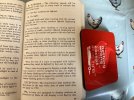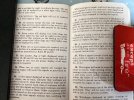The Sunset SD40s started to arrive at the beginning of June, mine were waiting for me in Chicago.
View attachment 218930
Here's the CP one being run in on the rolling road. and below the Mopac one
View attachment 218931
The SP one is a tunnel motor so it looks quite different at the back.
View attachment 218932
Fortunately Right O Way offer drop in wheel sets to convert these to P48, it's a bit more complicated than the GP9s as the trucks are sprung.
View attachment 218933
So for each axle you need to remove the axle box keeper plated the gear box keeper plate and remove the old wheelset and axle boxes, you just need to eb careful not to lose a spring or a screw.
View attachment 218934
These are nice models, but there are a few howlers !
You can barely see the air tanks when they should stand out a mile, the inertial air filter shouldn't have a surround, and there are n frames under the trucks, but most people will never notice.
The one thing that does confuse me is that the marker lights are all set to come on in the direction of travel, whereas on all my Atlas models they are set to come on in the opposite direction to travel. So I suspect these SD40s are wrong . Does anyone know for certain ?
























